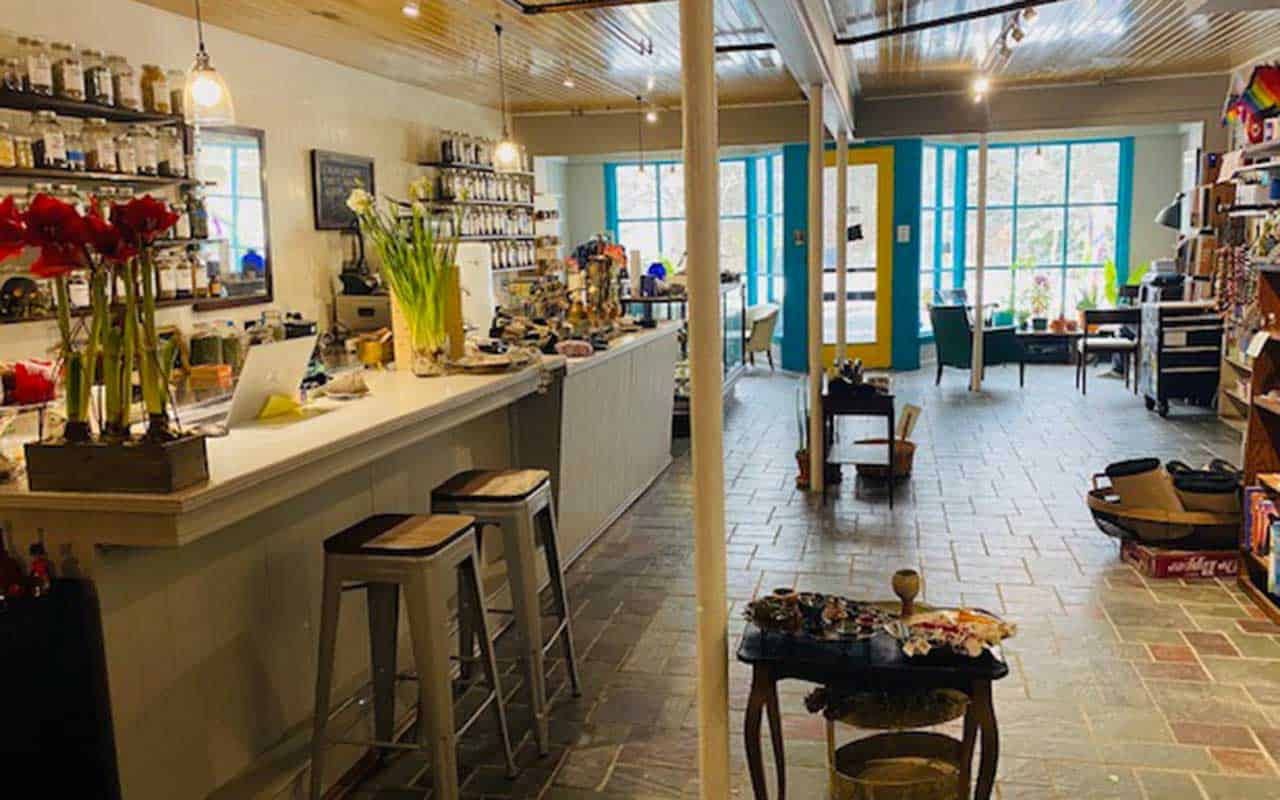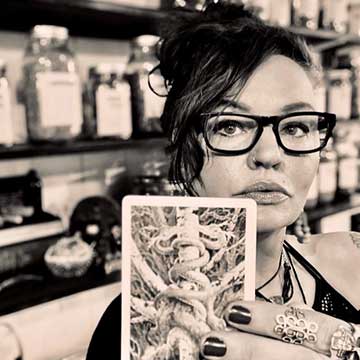This Month’s Featured Article

Reading the Cards
 It’s Sunday, and I’m on a walk and casting about for something to do. A manicure? Nah. Hmmm… what’s this? A drop-in tarot reading? Why not?
It’s Sunday, and I’m on a walk and casting about for something to do. A manicure? Nah. Hmmm… what’s this? A drop-in tarot reading? Why not?
I’d been seeing posts about tarot on Instagram and in articles here or there. This year, Dior launched its spring/summer collection with an opulent tarot-inspired video, and the UK’s The Sun has a daily tarot card interpretation on its website.
Significant upheavals in my life and the never-ending COVID cloud have me wondering about the bigger picture, a universe beyond what is traditionally knowable, and heeding calls less from the head and more from the heart. And I’m not alone. Tarot card purchases and readings have seen a noticeable uptick during the past few years. So, what’s the draw? For me, tarot cards seem like the perfect combination of mystery and metaphor but are just on the safer side of fortune-telling or psychic predictions. I’m curious but skeptical and probably more open than ever to access points other than religion to the spiritual and the divine.
Again, it’s not just me. A 2018 Pew Research Center survey found that 60 percent of both Christian and non-religiously affiliated adults believe in at least one of the New Age practices and ideas of reincarnation, astrology, psychics, and the presence of spiritual energy in physical objects such as mountains or trees.
Tarot history
Tarot’s roots go back to 15th Century Italy as playing cards. Hand-painted and elaborate, upper classes used them for entertainment, not divination. The oldest surviving set of tarot cards is the Visconti-Sforza deck commissioned by the Duke of Milan Filippo Maria Visconti and his successor Francesco Sforza. The Morgan Library in New York City possesses 35 cards in its online collection.
In the late 18th Century, Jean-Baptiste Alliete, also known as Etteilla (the mirror image of his surname), designed and adapted the deck as a tool for fortune-telling.
In 1910, William Rider published the tarot deck most recognizable today. The Rider-Waite deck, commissioned and created by Arthur Edward Waite, was illustrated by Pamela Colman Smith. It’s one of the early mass-produced fully-illustrated decks.
Majors and Minors
A tarot deck comprises 78 cards with four suits. Twenty-two numbered cards are the Major Arcana. These cards represent archetypes, characteristics, virtues, situations, and journeys you face in your life as a whole. They are the big guns of the tarot deck and carry heavy symbolism. Beginning with the number zero, The Fool card, and moving through The Hermit, Strength, Justice, The Wheel of Fortune, Love, and Death (symbolizing transformation), they culminate in the 21st card, The World.
The Minor Arcana are 56 suited cards that focus on our daily lives with situations, characteristics, encounters, and choices that regularly confront us. They are similar to the order of playing cards with a sequence of aces through ten of each suit and the court cards containing a page, knight, queen, and king. Each of the four suits represents one of the four elements that compose the universe:
• Wands (Fire) represent sparks of creativity that inspire action.
• Cups (Water) represent emotions, love, and relationships
• Swords (Air) represent intellect, logic, and analytical thinking
• Pentacles (Earth) represent our physical being and the needs of everyday life
Uses of a tarot deck
Since this article introduces tarot, slowly delving into the cards is critical. I purchased the Easy Tarot Kit with handbook by Josephine Ellershaw, a deck of cards illustrated by Ciro Marchetti, and a template for the Celtic Cross Spread, a more complicated drawing and arrangement of the cards. The book gives general meanings of the cards, and Ellershaw explains how she uses them and orients the reader to tarot.
Closer to home, Rebecca Guanzon was my guide. Guanzon is co-owner of Wild Soul River, with her life partner justin adkins. Located in Williamstown, MA, Wild Soul River is a community gathering space that offers energy healing, herbal consults, workshops, crystals, tarot readings, and most of all – space for passers-by (like me) and practitioners to explore and gather together. It was here that I had my first tarot reading with Guanzon’s longtime tarot mentor, Cat England.
Guanzon read tarot for herself for many years before reading for others. Working with trauma survivors for over 25 years, Guanzon characterizes her approach as trauma-informed tarot. Is that a thing? Well, maybe not. But it’s her thing.
She views tarot as energy work, akin to Reiki, another healing art she practices. “A tarot reading is a sacred relationship between you, the cards, and the person guiding the reading. This relationship creates energy and movement. Tarot allows exploring our intuitive side, making sense of our own experiences, where we are the expert.”
Reading the cards
As a reader, Guanzon begins with a grounding meditation. “I do this to create a place of space and trust and to connect with precious human sitting across from me. In my reading practice, I’m not a fortune teller. I’m creating an energy relationship with a person using the images and metaphors presented in the cards. I feel the energy, think about traditional meanings and explore what the imagery and metaphors might mean to the person sitting across from me.”
Guanzon uses tarot to bring her clients into their bodies, moving more into their gut and heart and away from a cerebral, intellectual way of processing experience. She observes that her clients want more meaning and connection to others and the Earth. She wants them to connect to their energies and intuitions and sees tarot as the perfect medium for that.
Each tarot reading brings its own unique dynamic between her and the client. Guanzon has observed that “Some folx have a specific complex situation that they are navigating and looking for direction. Some prefer to be more on the silent side and just see what the cards are bringing and others have a desire for dialogue. Some folx utilize this method as a therapeutic form of processing and understanding themselves more deeply. And all of those approaches are perfect. Each person seeking the reading is sitting in their own intuition and asking for what they need, want, or desire.”
When reading, she’s looking for how cards play off of each other when drawn and laid out. This relationship between the cards is an integral part of tarot reading. The cards work in tandem, forming an intuitive narrative of the person’s past, present, and potential future.
Guanzon explores the duality presented in each card, which represents our own lives and personalities, and contains the continuum of experience in between. Guanzon explains, “The sun card has a happy, warm and joyful side. It can also mean depletion and feeling the imposter syndrome. I think about how might this relate to the person I’m reading for and the other cards that also came up.” She’s also looking at the card’s image’s artistic elements, trusting that what draws her eye carries meaning.
Tarot for self-care
Aside from participating in a reading, there’s another way to use tarot – self-readings. According to Guanzon, tarot is an excellent tool for meditative self-care and self-affirmation, guiding your intentions for the day and becoming more in touch with your intuitive gifts. “We are intuitive beings, and I find there isn’t the space in our culture to talk about a deep knowing and reconnecting with that part of ourselves – and that part in others.”
Beyond reconnecting with ourselves is the possibility of connecting with what Ellershaw describes as the super-conscious or universal consciousness. “Think of it as a stream of pure energy; it is the link between us all, the field of interconnectivity. This is where inspiration, invention, ideas, and creativity manifest,” she writes.
Guanzon suggests that another way to use the tarot is to prompt creative writing and journaling. In the Easy Tarot Handbook, Ellershaw offers a tarot diary as a way to begin exploring the deck. While a working tool for connecting the deck to your own experiences, it also familiarizes you with each card’s meaning. Start with one card at a time and record the card’s traditional meaning, as outlined in the book. From there, write what the card might signify in your experience or the experiences of those around you.
For example, The Tower card in the Handbook represents beliefs and philosophies that undergird our lives. The lightning strike that begins the tower’s demise signifies the light of the truth – an awakening or awareness to things as they truly are. While this card may be jarring or unsettling, it brings with it the possibility to rebuild a tower on a firmer foundation. How could this card relate to your life? How could it give you the courage to pull down a tower you’ve seen cracks in, knowing on some level that what it represents isn’t part of your authentic, deeper self? Could that crumbling be a relationship? A job? A belief?
The goal is to use the card to write about what you’re feeling, but uncensored, unfiltered, uncut, and no second-guessing. There’s time to go back and reflect later. Don’t let the judging mind get in the way of that glimpse into the deeper knowing Guanzon refers to. This tarot journal provides space for reflection and includes time for “tarot to marinate. The messages on the card resonate more deeply as time goes on.”
Ethics of tarot
For Guanzon, “A tarot reading is no party trick. It’s a moment to hold another person and bear witness to them. It’s a sacred relationship that allows me to be both teacher and learner. I’m constantly going deeper into the cards through each reading.”
She advises clients to ask about a practitioner’s experience, how they approach readings, what they believe tarot can do. Beware of anyone willing to opine on medical issues or specific future events. Stay away from active solicitations on the internet.
Ask the practitioner about aftercare. Guanzon describes her approach, “I have my clients take pictures of the cards. I offer ways to reflect on them after the reading, and I advise them to be gentle with themselves. We’re working with energy and letting the cards seep into areas of our minds and bodies we might not be used to seeing the light of day.”
While the efficacy of tarot to predict your future might be a stretch, its use as a tool for self-care and accessing energy and intuitive knowing is real. It can provide the reflective prompt for a slower, more profound examination of our lives, relationships, and how we respond to situations we’re presented with. If that’s the power of tarot, deal me in.
You can find Wild Soul River at 248 Cole Avenue, Williamstown, MA, and reach Rebecca and justin at info@wildsoulriver.com or (413) 597-1172 or visit www.wildsoulriver.com.
Moonwake Yoga Studio in Millerton, NY offers an online introductory tarot mini-course. For more information and to register, visit www.moonwake.life.



